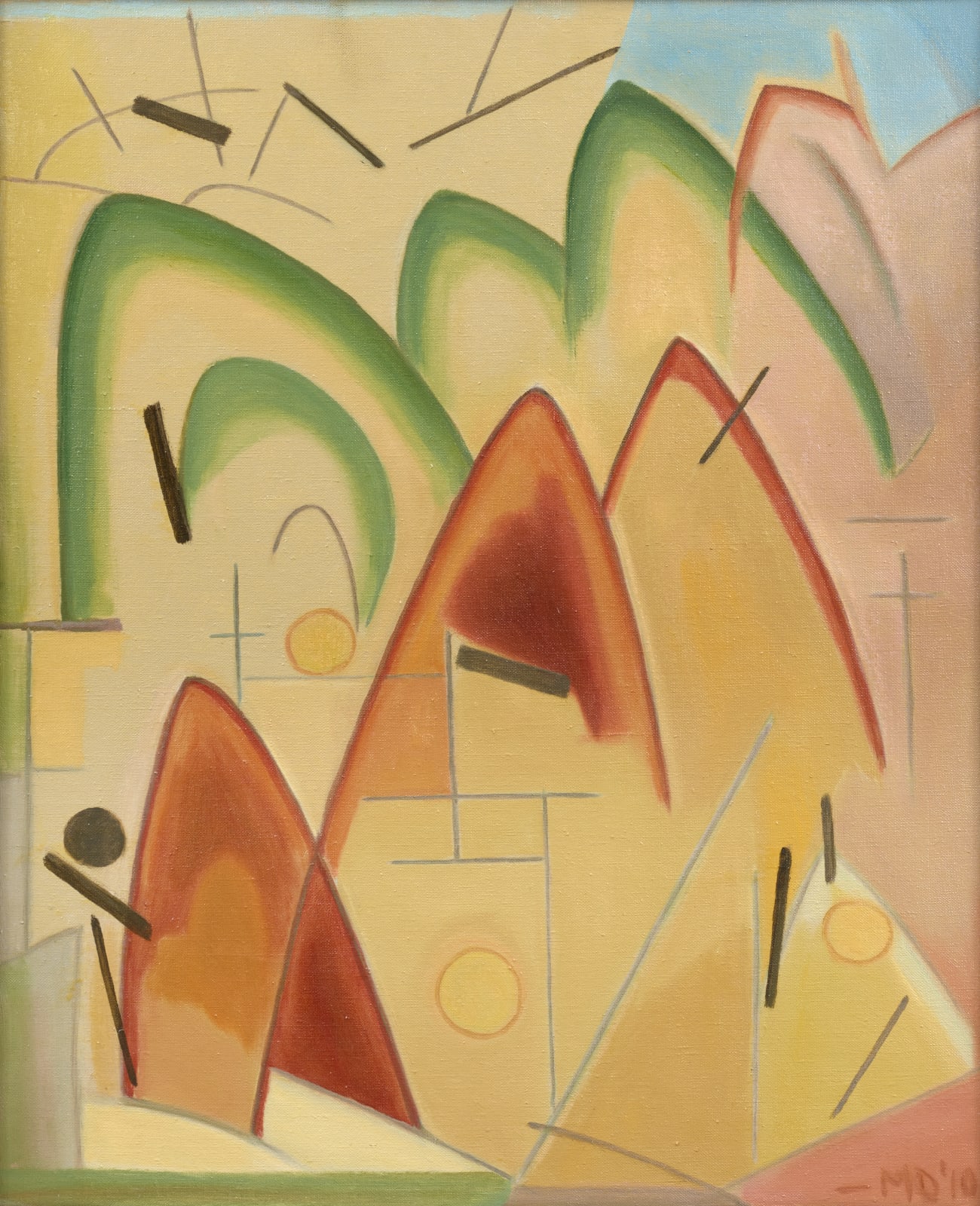Manierre Dawson American, 1887-1969
76.5 x 50.8 cm
Schoelkopf Gallery is the exclusive worldwide representative of the Estate of Manierre Dawson.
Prognostic (Right Panel of Triptych) belongs to a series of seven paintings by Manierre Dawson from early 1910 that are considered among the earliest examples of abstraction in America. The triptych was not exhibited together until the 1976 retrospective of the artist's work shown at the Museum of Contemporary Art, Chicago, Illinois. Dawson made his mark on abstraction in the early twentieth century, using techniques that merged his mastery of mechanical drawing with geometric and mathematical themes and a bright, rich color palette. In his early years, Dawson studied structural engineering, a practice that informed his later abstract explorations of dimensional space. These compositions were seen as revolutionary when they were first exhibited in the years surrounding the Armory Show (1913). Reflecting on the piece in 1969, Dawson explained, "Prognostic is one of seven paintings (the others are smaller) painted shortly after I graduated from college, where I had so many engineering and mathematic courses that their influence of this shows in the backgrounds of coordinates and superposition of differentials. The black lines and circles thrown over these are subconsciously possibly suggested by the pencils, pens, and erasers generally strewn over a student's drawing board."
Historically overlooked, but among the first true abstract painters in America, Dawson first explored non-representational painting in the years between 1910 and 1914, during his travels through Europe. Already advancing in Europe during the pre-World War I period was a shift from Realism and Impressionism towards Expressionism, which favored an abundant use of color over formal perspective and line. In her review of the 1988 Whitney Museum Museum of American Art exhibition on Dawson’s early abstractions, Roberta Smith, an art critic for the New York Times, compares Dawson’s work to that of Wassily Kandinsky, Piet Mondrian, and Arthur Dove. Commenting on Prognostic, Smith observes, “vaulting arcs suggest mountains or trees, while yellow dots bring to mind a series of glowing suns. Strange as it sounds, these images could have been inspired by looking directly into the sun and then looking at the landscape through a haze of light and spots. Black dots and six short lines energize and syncopate their compositions.” Dawson's work is included in prominent public collections, including the Metropolitan Museum of Art, the Smithsonian American Art Museum, the Hirshhorn Museum and Sculpture Garden, and the Art Institute of Chicago, among several others. The central panel of the triptych was acquired by the Milwaukee Art Center in 1967, while the left panel remains in a private collection.
Provenance
The artist; toEstate of the artist;
[Robert Schoelkopf Gallery, New York, by 1969];
[Sid Deutsch Gallery, New York, 1976];
Harold Rand, New Rochelle, New York, by 1977;
[Martin Diamond Fine Arts, New York, by 1982];
Tommy and Gill LiPuma, Los Angeles; to
[Salander-O'Reilly Galleries, New York]; to
Private collection, Dallas, 1984 until the present
Exhibitions
Museum of Contemporary Art, Chicago, Illinois; Indiana University Art Museum, Bloomington, Indiana; Maryland Art Gallery, University of Maryland, College Park, Maryland, Manierre Dawson (1887-1969): A Retrospective Exhibition of Painting, November 13, 1976-May 1, 1977Martin Diamond Fine Arts, New York, Four Decades of American Modernism, October 5-November 13, 1982, illus. on cover of exhibition announcement
Los Angeles County Museum of Art, California, May-October 1984
Whitney Museum of American Art, New York, Manierre Dawson: Early Abstractionist, July 8-September 11, 1988
Hollis Taggart Galleries, New York, Manierre Dawson: American Pioneer of Abstract Art, October 1-30, 1999 (illus. for exhibition brochure)
Literature
Manierre Dawson, Record of paintings and sculpture, "1910”: "Triptych—Right Panel, 24 x 20, canvas (not shown together)," Manierre Dawson papers, 1904-1963, Archives of American Art, Smithsonian InstitutionKenneth R. Hey, "Fix on the Phantoms of the Imagination," Archives of American Art Journal, vol. 12, no. 4, 1974, p. 7
Stephen Prokopoff and Mary Mathews Gedo, Manierre Dawson (1887-1969): A Retrospective Exhibition of Painting, Chicago: Museum of Contemporary Art, 1976, pp. 10-11 and 15-16
Mary Matthews Gedo, "Manierre Dawson: The Prophet in His Own Country," American Art Review, vol. 4, no. 3, December 1977, illus. p. 72
Mary Mathews Gedo, "Modernizing the Masters: Manierre Dawson's Cubist Transliterations," Arts Magazine, vol. 55, no. 8, April 1981, p. 137
Mark H. Bessire and Mary Jo Peer, Manierre Dawson: Early Abstractionist, New York: Whitney Museum of American Art, 1988, pp. 5-6, illus. p. 3
Roberta Smith, "A Forgotten Pioneer in Completely Abstract Painting," The New York Times, August 26, 1988, p. C19
Matthew Baigell, A Concise History of American Painting and Sculpture, New York: Harper Collins, 1996 (revised edition of Icon Editions, Harper and Row, New York, 1984), p. 233, illus. fig. 230
Hollis Taggart, Vivian Bullaudy, Henry Adams, and Randy J. Ploog, Manierre Dawson: American Pioneer of Abstract Art, New York: Hollis Taggart Galleries, 1999, pp. 16-21, illus. pl. 16
"Manierre Dawson An American Pioneer of Abstract Art," Antiques and the Arts Weekly, September 24, 1999, p. 154
"Hollis Taggart Galleries Has Groundbreaking Show of American Modernist Manierre Dawson," Antiques and the Arts Weekly, October 8, 1999, p. 112, illus.
Hollis Taggart Galleries, Art Market Report, Fall/Winter 1999, p. 3, illus. p. 5
Randy J. Ploog and Henry Adams, Manierre Dawson: New Revelations, New York: Hollis Taggart Galleries, 2003, pp. 14, 31, 36, illus. p. 14, fig. 9
Randy J. Ploog, Myra Bairstow, Manierre Dawson (1887-1969): A Catalogue Raisonné, New York: Hollis Taggart Galleries, 2011, pp. 28-30, 33, 42, 156, no. 1910.28, illus. p. 155
Subscribe to our mailing list to receive updates from the gallery
* denotes required fields
We will process the personal data you have supplied in accordance with our privacy policy (available on request). You can unsubscribe or change your preferences at any time by clicking the link in our emails.

